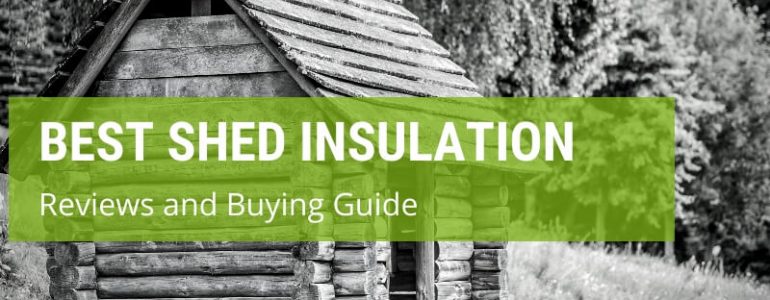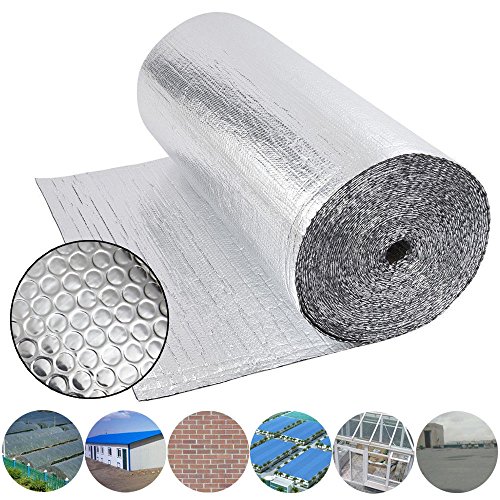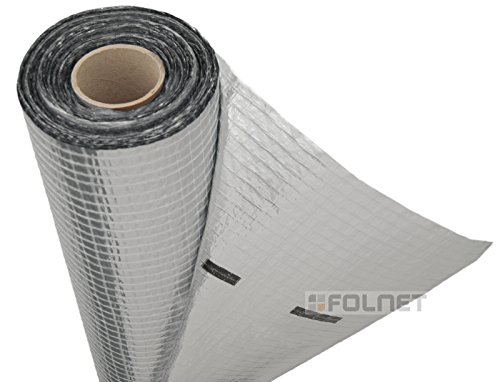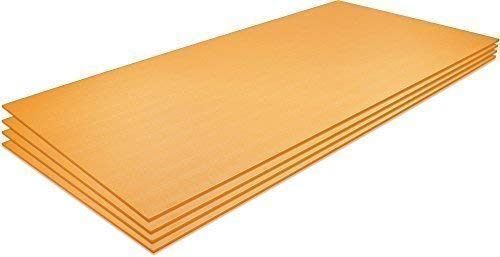Shed insulation keeps the inside cool when it’s hot outside and keeps heat in when it’s cold outside. This (together with a good heating solution) turns your shed into a comfortable all-year round workspace.
If you plan to use your shed as an extra bedroom or a summerhouse, proper insulation is essential.
Shed insulation is not just important for temperature control; it prevents excess moisture from getting into the shed. This protects your tools and equipment from rusting.
There are several types of shed insulation ranging from cheap bubble wrap to high-performance Polystyrene boards.
The best type of insulation will depend on your insulation needs (how cool or warm you want the shed to be) and budget.
What To Consider When Choosing Shed Insulation
a) Type of Insulation
Here are the most common types of insulation used in sheds.
Bubble wrap
Bubble wrap is the cheapest and most basic type of shed insulation. It consists of sheets of bubble wrap that you staple or tack to the inside of your shed.
The air inside the bubble wrap acts as insulation, preventing excessive heat loss from inside and too much heat entry from outside.
Bubble wrap is very easy to install, but is not as effective as other types of insulation.
Aluminium foil-backed bubble wrap
If you are looking for affordable shed insulation that’s a bit better than basic bubble wrap, get foil-backed bubble wrap.
It consists of bubble wrap with aluminium backing on both sides.
The aluminium foil reflects heat. This prevents outdoor heat from getting into the shed and indoor heat from escaping.
Foil-backed bubble wrap will provide better insulation than bubble wrap on its own but it still doesn’t compare to other types of insulation like Rockwool or foam boards.
It’s enough if you are just using the shed for storage and as a workspace. But if someone will be sleeping there, use a higher performance insulation.
Insulation boards and panels
These are made from different materials such as polystyrene, polyisocyanurate and polyurethane. Some of these boards come with foil backing to reflect away heat.
Insulation boards are generally better than foil or bubble wrap at regulating temperature and moisture.
Wool
There are different types of wool used in insulation.
If you want a natural insulation, get sheep’s wool. It’s safe to handle and has excellent insulating properties. But it is pricey.
Glass wool is much cheaper and very easy to work with. It is also resistant to burning. But it can irritate the skin so be careful when applying it.
Mineral wool insulation such as Rockwool has excellent thermal insulation properties and is cheaper than natural wool. But like glass wool, it can irritate your skin and eyes.
Spray foam
Spray foam is one of the most effective shed insulations thanks to its ability to penetrate nooks and crevices.
It also has excellent water protection properties, which keeps your shed free from mould.
And because it completely covers up your walls and roof, there’s no place for pests and bugs to live.
b) Shed Size and Coverage Area
Knowing the size of your shed will help you choose the right size of insulation. You may need to buy several rolls or packets of insulation to fit your shed.
To determine how much insulation you need, check the length of the foil or the size of the boards.
The amount of insulation you need also depends on which areas you want to cover. If you plan to cover the walls, roof and floor, you’ll need plenty of insulation.
c) Ease of Installation
If you want something fast and easy to install, get bubble wrap or foil-backed bubble wrap insulation. You just need to cut it to size and staple it to the inside of the shed.
Foam sheets are also easy to put up. Again, cut to size and attach to the walls.
Spray foam takes more time to add to your shed but it’s still something you can handle on your own.
As long as you have a couple or so hours to spare, you can install most types of insulation on your own.
How To Insulate A Shed
Before you put up the insulation, first inspect your shed to make sure it is in a good condition. It makes no sense to install insulation if the windows are broken or the roof is leaking.
Inspect every inch of the shed and make repairs where necessary. Make sure your shed doesn’t allow draught or water in.
This may involve patching the roof or even putting in a new roof, repairing the door or replacing it with a weatherproof door and replacing broken windows.
If your doors and windows are in a good conditions but have gaps that allow air through, use expanding spray foam to seal off those gaps.
Once you are satisfied your shed is in a good condition, buy your preferred insulation and install it as per the manufacturer’s instructions.
Here are some helpful tips to keep in mind when installing shed insulation.
- Install bubble wrap or foil on the shed frame rather than directly on the cladding. This ensures there’s an air gap left between the insulation and the walls. This prevents condensation build-up, which can cause mould and damage the walls or the insulation.
- Overlap insulation by about 10-20cm to create a complete heat barrier.
- Further secure the edges of insulation and areas where they overlap with insulation tape.
- Cover the insulation with plasterboard, plywood or hardboard. For foil and bubble wrap insulation, you can leave it uncovered though it may not look very appealing.
Remember to take caution when handling certain types of insulation like fiberglass or rockwool. Wear protective gear.
The Best Shed Insulation Reviews
1. SuperFOIL SFBA Bubble Foil Insulation, 7.5–150sqm
SuperFOIL SFBA is our top recommendation if you are looking for shed insulation that’s easy and quick to install.
There’s no art or science to putting up the SuperFOIL SFBA foil insulation. Simply cut it to the size you need and staple it to the wall, roof or floor.
Because the foil is very flexible, you’ll have no trouble applying it around corners. Use insulation tape to secure the edges of the foil for airtight insulation.
Note that the tape and staple gun are not included.
The roll consists of a layer of bubble wrap with foil backing on both sides. The air in the bubble wrap acts as an insulator while the foil reflects heat, ensuring indoor warmth stays inside and outdoor heat stays outside.
The foil also provides vapour control, which helps keep your shed damp and mould-free.
SuperFOIL SFBA insulation is available in different roll sizes ranging from 0.75m x 10m (7.5sqm) for small applications like insulating a storage cabinet in your shed to 0.75m x 200m (150sqm) for insulating large sheds.
All rolls have 3mm thick foil.
What I like about it:
- Good temperature insulation.
- Provides moisture and noise insulation as well.
- Easy DIY installation.
- Multiple sizes available.
2. Dripex Double Aluminium Bubble Foil Insulation, 6–60sqm
The Dripex double aluminium foil is another good choice if you want insulation that’s easy to put up in your shed.
Dripex has the same design as SuperFOIl SFBA: two layers of reflective aluminium foil with bubble wrap in the middle.
It’s not as good as Rockwool or spray foam, but as long as you are not planning to live in the shed, it’s good enough for protecting your tools and equipment from moisture and extreme temperatures.
It also provides some noise dampening, which can help if your shed is located near a road.
To get the best results, make sure you leave a space of at least 20mm between the foil and the wall. If you are planning to cover the foil with plywood, MDF or plasterboard, make sure you also leave a 20mm cavity at the front.
You can use the Dripex foil insulation on any part of the shed including the walls, under the floor and under the roof.
Dripex is available in several roll sizes ranging from 0.6m x 10m (6sqm) to 1.2m x 50m (60sqm). Whether you need to line just the walls or cover the entire shed, you can choose the perfect size for your needs.
What I like about it:
- Easy to put up.
- Makes an instant difference – you’ll immediately notice less dampness and a more constant temperature.
- No maintenance required.
- Multiple sizes available.
3. Strotex Vapour Barrier and Waterproof Thermal Insulation, 75sqm
If one of your main concerns is water entry into the shed, we recommend the Strotex waterproof thermal insulation.
It has a 3-layer design that keeps both heat/cold and water out.
Instead of the usual foil-bubble wrap-foil design, the Strotex insulation consists of aluminium film on both sides with a polypropylene (PP) layer in the middle.
The use of PP instead of bubble wrap greatly increases the insulation’s tensile strength and makes it waterproof.
For insulation, the three-layer design works in two ways.
One, the outer aluminum foil surfaces reflect heat away from them. This retains indoor warmth inside the shed and keeps outdoor heat from getting in.
When it’s hot, the shed doesn’t turn into a sauna and when it’s cold, you’ll still feel warm when working in the shed.
The inner PP layer also helps with insulation by absorbing excess heat.
Strotex is available in only one roll size – 1.5m x 50m (75sqm). But you can order packs of one, two or three rolls depending on how much space you need to insulate.
What I like about it:
- Waterproof.
- Tough, durable and tear-resistant.
- Excellent thermal insulation for sheds as well as other applications such as conservatories and attics.
4. Prowarm ProFoam Insulation Boards, 10sqm
If you want to insulate the floor of your shed, Prowarm ProFoam insulation boards are much more effective than sheets of foil.
ProFoam XPS (extruded polystyrene) boards are designed for use with electric underfloor heating systems. But you can also use them on their own under your shed’s wooden floor.
A significant part of warmth from your shed is lost through the floor. Cold and moisture from outside also get in through the floor.
Installing ProFoam boards under the floor will greatly cut down on heat loss and moisture entry. For better overall insulation, consider combining them with foil insulation on the walls and roof.
Installing insulation boards is easy especially if you’ve not yet laid down your shed’s floor. Just lay down the boards between floor frames and lay down the flooring on them.
You can cut the boards to size using a sharp knife. Cover joints between boards with tape for complete moisture and thermal insulation.
If you’ve already put down the floor, you’ll have to pull it up to lay down ProFoam insulation boards. Note that ProFoam boards work only under wooden floors.
The boards come in a pack of 14, each covering 0.72sqm for a total coverage of 10sqm.
What I like about it:
- Excellent floor thermal insulation.
- Also protects against moisture entry.
- Easy to install under the floor.
5. UKPS 12 Large Polystyrene Foam Boards, 8.6sqm
Polystyrene is one of the best thermal, moisture and noise insulators. These UKPS boards use Expanded Polystyrene.
While it’s not as effective an insulator as extruded polystyrene, it’s perfect for a shed. You can use the sheets to insulate the shed’s floor or walls.
They are easy to install. Just lay them between studs and attach them to the shed cladding using glue. The foam boards are not dense so you should have no trouble cutting them with a sharp knife.
Their lightweight nature, however, comes with a downside. They easily get damaged during shipping. Almost every customer says some of the boards were damaged.
We recommend ordering more than you need to cover the ones that’ll be damaged. But you can still use partly damaged boards.
Each board measures 1.2m by 0.6m and are 2.5cm thick. The total area for the 12 boards is 8.6sqm.
What I like about it:
- Easy to install.
- Good moisture and thermal insulation.
- Affordable.
Frequently Asked Questions
Is it worth insulating a shed?
Insulating a shed may be a bit of an investment, but it is one that is worth its weight in gold. If you insulate your shed you will not experience half the problems you will do if you do not insulate it. Whatever you are using your shed for, you really should insulate it. A well insulated shed is a well looked after shed, and as such it is one that will look after you for the future.
Insulating your shed will prevent the ingress of damp and mould, so it should be an ideal place for storing vegetables that you harvest from your garden.. If you are using it as an extension of your inside space then you want it to be warm and cosy, right? It cannot be this without being insulated!
An insulated shed is a shed that will last. You can prevent any damage or denigration to your shed if you insulate it against the elements; doing this will ensure its longevity and usefulness for the future.
Should I leave an air gap when insulating a shed?
Leaving an air gap between the outside wall and the insulation is essential, when insulating a shed. If the insulation is touching the outside wall the you may as well have not bothered!
The air gap is to protect the insulation from the cold, wind and damp that will be affecting the outside walls. Without this gap, the insulation won’t be able to do its job, so yes, you definitely need to leave an air gap.
How do you insulate a gardening shed?
Because a shed doesn’t have to be pretty, just functional, there are some very cheap ways you can insulate it:
- Bubble wrap. Simply measure the walls and cut strips of bubble wrap to the right height and width, then use a staple gun to fasten them to the walls. Screw sheets of MDF or other cheap flat wood over the insulation, to cover it.
- Fibreglass wool. Tack a breathable membrane to the walls then having covered your mouth and put on protective gloves, place the fibreglass insulation over the membrane. Cover the fibreglass with a solid wood panel and screw into place.
- Insulate the floor. A lot of heat is lost through the floor, especially if it is a dirt floor or the shed is placed directly on the ground. You can get around this simply and cheaply, by laying a piece of old carpet and a rug or two.
- Check the windows. Drafts can come whistling in through the gaps by the windows and doors in a shed, so fill any visible gaps with expanding foam.
- Insulate the roof. You should use the same methods for the roof as you do for the walls. Additionally, check the roof for any gaps or leaks that could be causing drafts, or that may wreck your careful insulation.








